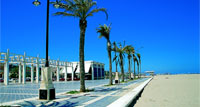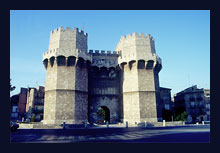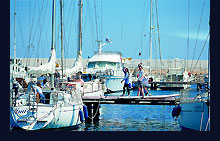|
 |
 |
| THE WEATHER IN VALENCIA |
 |
| In September, the weather is still warm but not too hot. |
Valencia has one of the most benign climates of Europe. It is characterized by a mild, typically Mediterranean climate, with the average annual temperature rising above 17ºC. Summers are warm and winters are very mild. During the winter months the temperatures usually do not fall below 10º C. Rainfall is scarce and usually appears in autumn, at the end of winter and in early spring. |
|
|
|
 |
 |
VALENCIA AND ITS REGION
Comunitat Valenciana |
 |
The beaches of the Region of Valencia are undoubtedly some of the best in Spain, with hundreds of kilometres of Mediterranean coastline to be enjoyed, ensuring visitors an unforgettable stay. Not only are the beaches wonderful but the community is also an excellent area for water sports and sailing. It has one of the best regatta venues in Europe and is one of the most active and important harbours of the Mediterranean. |
The region also has more than twenty golf courses created by some of the most prestigious designers and champions - making the Region of Valencia the perfect place to enjoy the best golf in Spain with excellent all-year-round weather. The best-known Golf club is El Saler, where The Seve Trophy was held. |
 |
|
The cultural calendar of the towns and villages of the community overflows with events and festivals that combine traditions and customs with current affairs in which everyone can participate. A good example of this is the Fallas festival in March of each year. |
 |
The City of Valencia
Valencia, situated in the Mediterranean coast of eastern Spain, is the capital city of the autonomous region Comunidad Valenciana. For several centuries it was the capital city of the Kingdom of Valencia, part of the confederation of kingdoms of the Spanish Crown. Currently, it has around 650,000 inhabitants.
There are two public universities: Universitat de València-Estudi General, founded in 1499, with a generalist approach, and Universidad Politécnica de Valencia, focused on technical studies (although including the old Fine Arts School of Valencia). In addition, there are two new, small private universities.
Not many cities are capable of so harmoniously combining a fine array of sights from the distant past with innovative, "avant-garde" constructions now being erected. Valencia, whose founding dates go back to 138 BC, is one of these fortunate few. From the remains of the Roman forum located in today's "Plaza de la Virgen" - part of the Roman city of Valencia - to the emblematic City of the Arts and Sciences, this town has transformed its  physiognomy over the years while preserving its monuments from the past. physiognomy over the years while preserving its monuments from the past.
Sightseeing around the city begins in the old quarter. Until the mid-nineteenth century, it was defended by a wall, the inner route of the number 5 bus.
Still standing as proof are the graceful “Torres de Serranos”, the spacious “Torres de Quart” and some remains of the apron wall in the basement of the Valencia institute of Modern Arts http://www.ivam.es/.
|
The Market District took shape around the commercial life of the city's inhabitants. Accordingly, its two most emblematic buildings are used for trading purposes. The Gothic building of "La Lonja", declared by UNESCO as a heritage of humanity, features a beautiful columned room where the old tables on which trading transactions were finalised are still in use today. On the other side of the Turia's old river-bed lie the nursery gardens, along with the Fine Arts Museum and the modern part of the city. The futuristic face of the city is mirrored on the old river-bed through the Gulliver Children's park and the leisure and culture complex "Ciutat de les Arts i de les Ciencies" http://www.cac.es/. Life in the city spreads down to the seafront with the harbour and the beaches of "Las Arenas" and "La Malvarrosa". |
 |
| ECONOMY |
 |
 The city of Valencia, as capital of the Region of Valencia, is a well-developed economic area dominated by services. Today the services sector accounts for 76% of total employment. The city of Valencia, as capital of the Region of Valencia, is a well-developed economic area dominated by services. Today the services sector accounts for 76% of total employment.
Most Valencian companies are small or medium sized, but some multinationals such as Ford and HP have a strong presence in the region.
|
The main industrial sectors include: the car industry, wood and furniture, metal products, paper and graphic arts and porcelain, as well as the marble industry, footwear and clothing. |
In addition, although agriculture has a lesser importance, it still extends over 3 millions square metres. Most is used for horticulture, with rice and oranges both having a long tradition in Valencia. |
The Valencia Trade Fair, where Valencia celebrates one of the most important fairs in the porcelain area worldwide. |
The different Universities, both private and public, with more than 120,000 students guarantee a dynamic future for the Region of Valencia. |
 |
| IMPORTANT LINKS OF THE VALENCIAN COMMUNITY |
 |
| Generalitat Valenciana |
A web site about the Government of the Region of Valencia. It offers information of institutional matters, connects to other sites of official bodies governed by the regional authority. |
|
| Ayuntamiento de Valencia |
Web site of the City Council of Valencia, in which you can find a street map, information about topics related with the city and their inhabitants and the history of the city. |
|
|
|
|
|
|
| Valencia On-line |
Useful tourist information about Valencia, history, places of interest, museums. |
|
| Museo Nacional de Cerámica (in Spanish) |
The National Museum of Ceramic “González Martí” is located in the emblematic building of the Marqués de dos Aguas. In this Museum pieces of a high artistic values are shown. |
|
|
|
|
| Feria de Valencia |
Exhibition centre for trade fairs such as the International Furniture Fair. |
|
|
|
|
|
|
|
|
 |
|

